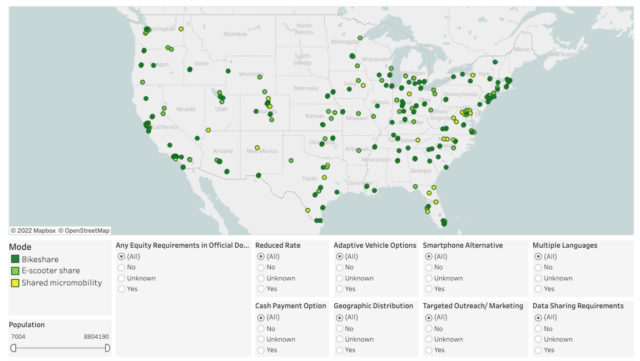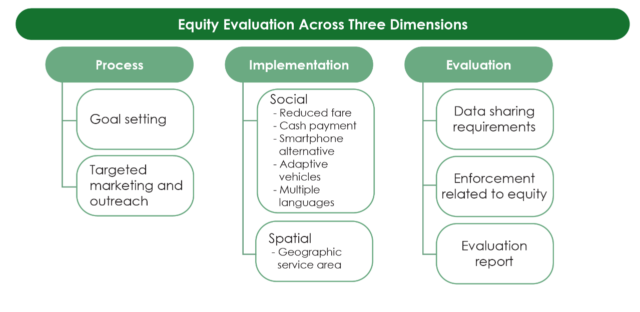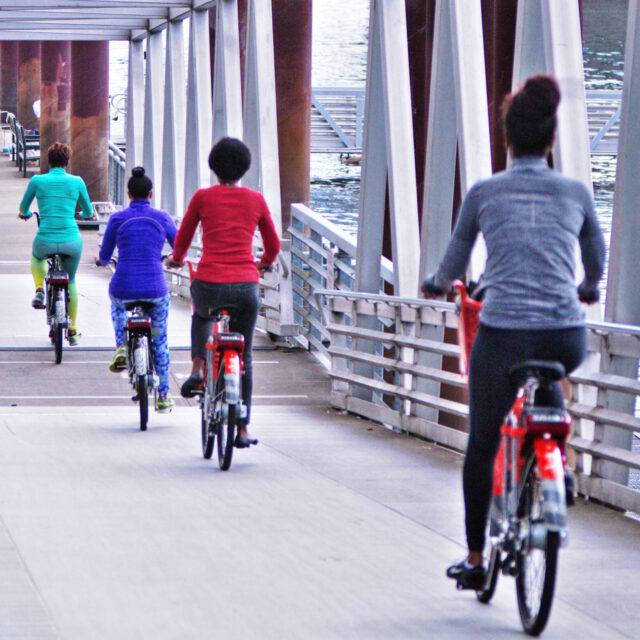Operationalizing Equity in Shared Micromobility
by Kiran Herbert, Communications Manager
August 26, 2022
A new online dashboard showcases equity requirements from 239 e-scooter and bike share programs across the United States.

The dots on the Equity Dashboard represent the shared micromobility programs surveyed in the study. Filters below the map let the user sort the programs by various criteria.
If you’re an agency or city looking to start a new shared micromobility program, there’s a lot to consider. In addition to sourcing hardware and software, there are organizational choices to consider, staff to hire, and permits to obtain. Equity programs are often an afterthought and until earlier this month, the industry lacked a comprehensive database outlining what other systems have done. Now, thanks to a team of researchers, interested parties can reference a new Equity Dashboard, whereby the equity efforts of one city might pave the way for another.
The research team was led by the University of Oregon’s Anne Brown and Amanda Howell and funded by the National Institute for Transportation and Communities (NITC).
“Our hope is, for companies or cities that are starting a new program, they can use the dashboard and find specific language for equity requirements in other comparable cities,” says Brown in a NITC blog on the project. “Micromobility companies are now going to smaller communities, but their staff often don’t have the bandwidth to study in depth what other places are doing.”
The dashboard is comprehensive yet easy to navigate, with filters that allow users to sort by population size, as well as things like whether or not a municipality has cash payment options, does targeted outreach, or has written equity requirements into its operating agreement. Now, if you’re a city looking to introduce adaptive vehicle options, rather than create one from scratch, you can reference programs from MoGo in Detroit, Divvy in Chicago, or CitiBike in New York City. Want advice on how best to do targeted outreach in a big city? Ask Indego in Philadelphia. Considering a way for folks to check out a bike without a smartphone in your 10,000-person town? Look to START Bike in Jackson, Wyoming.
While the research builds upon a 2018 equity study partially funded by the BBSP, this new work expands on the number of systems studied from 70 to 239, includes e-scooters alongside bike share, and compiles a wealth of regulatory language for others to draw from. Of the 239 programs studied, 149 of them (roughly 62%) had requirements related to equity. Other systems noted that equity-based programs were desirable but stopped short of making them mandatory.
Researchers found that the more common equity requirements across shared micromobility related to implementation equity, which includes things like low-income programs and multiple language options alongside a system’s geographical service area. Most common were requirements related to technology access, such as requiring smartphone-alternative access (such as kiosks or office hours, found in 35% of programs), cash payment options (33%), and a reduced fare option (32%). Just 5% of systems had a requirement to include adaptive vehicles for people with disabilities.
Interestingly, the study found e-scooter programs to have more equity requirements than bike share, although joint micromobility programs (where e-scooters and bike share are combined) fared best. The researchers also found that most cities and agencies that do enact equity requirements tend to focus on expanding access to shared micromobility services and that few evaluate outcomes.
“Unfortunately, there is still a disconnect between goals, implementation, and outcomes,” says Howell. “For example, cities want to expand access, so they will have a reduced fare requirement, but then they are not really collecting data to understand utilization of these programs. So, how effective are these programs?”

The Shared Micromobility Equity Evaluation Tool lets equity program managers see their equity “score” in three key areas: process, implementation, and evaluation.
Without good data, that question remains difficult to answer, emphasizing the importance of equity when it comes to planning, implementation, and evaluation. With this in mind, researchers also created a Shared Micromobility Equity Evaluation Tool, which takes between 20 and 45 minutes to complete. Once done, users are emailed customized “scores” reflecting their program’s strengths and opportunities for growth in all three areas, as well as a resource guide that points to promising approaches to consider when iterating existing programs or launching new ones.
Based on the cities and agencies studied, the research team also compiled a list of seven recommendations:
- Link operational incentives to desired equity outcomes. It helps to ensure that there is a clear arc connecting specific goals with program requirements.
- Dedicate staff time and resources to manage shared micromobility programs. Cities with staff dedicated to promoting equity in shared micromobility programs are instrumental in operationalizing robust equity offerings.
- Match each program requirement with targeted data collection. Data are needed to enable an assessment of how successfully each requirement is meeting its goals.
- Conduct transparent evaluations. Clear evaluations will help measure progress and identify future paths of improvement or iteration.
- Define program goals and agree on a shared definition of equity. Cities, regardless of the robustness of their city or program-level goals, should bolster the connections between stated micromobility program goals, required equity components, and collected data.
- Move towards a model of community empowerment. By and large, cities and agencies surveyed in this project did not conduct mobility needs assessments prior to launching a shared micromobility program. These assessments help identify and understand unmet needs in the community and develop solutions in partnership with those community members. An assessment could determine how a micromobility program would fit within the broader context of community priorities — or even if it was a priority. Significant change is needed in how they include community input, by dedicating resources to open-ended mobility needs assessments.
- Cities must pair program-specific efforts with broader efforts needed to truly advance equity. Even the most accessible shared micromobility programs cannot compensate for missing infrastructure or unsafe streets.
For those interested in diving deeper into the data or asking questions of the lead researchers, register for a free NITC webinar on September 21, 2022. From 11 am to 12 pm MST, Brown and Howell will present an overview of their findings and demonstrate both online tools. Participants will leave with a better understanding of the types of equity requirements currently in place across the U.S., as well as what can be done to take micromobility equity further.
The Better Bike Share Partnership is funded by The JPB Foundation as a collaboration between the City of Philadelphia, the National Association of City Transportation Officials (NACTO) and the PeopleForBikes Foundation to build equitable and replicable bike share systems. Follow us on Facebook, Twitter and Instagram or sign up for our weekly newsletter. Got a question or a story idea? Email kiran@peopleforbikes.org.



